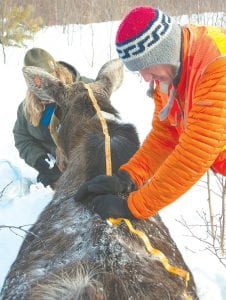The Minnesota Department of Natural Resources (DNR) is close to completing the first phase of a multiple-year $1.2 million project to attempt to determine why moose are dying at unusually high rates in northeastern Minnesota. One of our Cook County moose gets an exam from Erika Butler, DNR wildlife veterinarian and lead researcher on the adult moose mortality project and Quintin Slade, Quicksilver Air’s helicopter pilot.

Moose continue to die at an alarming rate, and with no end in sight the Minnesota Department of Natural Resources (DNR) has called an indefinite halt to the bulls only hunting season.
Last year 45 bulls were taken during the hunting season in the Northeastern Zone, which includes Cook County.
During 2012 the DNR said the northeast population declined 35 percent, and suffered a 52 percent loss from 2010.
In a press release on Wednesday, February 6, DNR Commissioner Tom Landwehr said, “The state’s moose population has been in decline for years but never at the precipitous rate documented this winter. This is further and definitive evidence the population is not healthy. It reaffirms the conservation community’s need to better understand why this iconic species of the north is disappearing from our state.”
Landwehr’s comments came on the heels of the release of the latest moose aerial survey conducted in January by DNR and 1854 Treaty Authority biologists. Since 1960 biologists have counted bulls, cows and calves from a helicopter or plane during January in selected plots over the Arrowhead region. Last January the count was 4,230 and this January it was 2,760. In 2006 the estimated count was 8,840.
While Landwehr said the state’s limited hunt wasn’t responsible for population decline, he added, “Taking this action is reasonable and responsible in light of latest data and an uncertain future. It’s now prudent to control every source of mortality we can as we seek to understand causes of population decline.”
Noted Isle Royale wolf/moose researcher Rolf Peterson agreed with the DNR’s decision to end the moose hunt.
“The DNR’s decision to suspend hunting makes sense given the disturbing and abrupt decline in moose numbers. To me, the big news is the incredibly disappointing survey results. The hunting decision is simply a logical reaction to an uncertain situation that researchers are trying to resolve.”
Wildlife researchers across the state have been working for years to figure out what is causing Minnesota’s moose to die, but so far haven’t pinned down any one or two causes. Some strong theories include illness spread by mosquitoes, parasites, ticks, and liver flukes that weaken moose immune system and cause them to starve or be killed by predators, and global warming. Hotter summers are tough on moose that are very heat sensitive.
In what might be a last ditch effort to figure out what is causing moose mortality, this January the DNR took the lead on the largest, highest tech multi-party moose research effort ever conducted.
The $1.2 million multi-year project will look at the cause of adult moose mortality, calf mortality, calf survival, and the habitat the moose are living in. So far, 92 moose have been fitted with tracking collars in Grand Marais, Ely and Two Harbors.
The goal is to put tracking collars on 100 adult moose and 50 calves, and implant 27 adult moose with instruments in their digestive tracks to let researchers know if they have died. Should a moose die, the scientists hope to retrieve the carcass within 24 hours before scavengers or predators get to the carcass.
Erica Butler, D.V.M. Minnesota DNR’s chief wildlife veterinarian is in charge of the latest study.
“We were very surprised by the survey results. The 35 percent mortality rate was much higher than reported for other populations. It certainly makes us wonder what could be causing such a fast decline; whatever it is must be acting fast. We were up to [collaring] 92 moose yesterday and have already done eight today, so we could be done with 110 by Friday, [Feb.8],” Butler said.
Locally, Sue Prom started an on-line petition to end moose hunting on January 28. Sue, with her husband Mike, owns Voyageurs Canoe Outfitters situated at the end of the Gunflint Trail.
On Twitter, Sue Prom said, “The results of the aerial survey are devastating. I was just lucky that I put the petition out there at a good/bad time.”
Should the numbers drop another 1,471 next year, there will be fewer that 1,300 moose in the Arrowhead Region.


Loading Comments